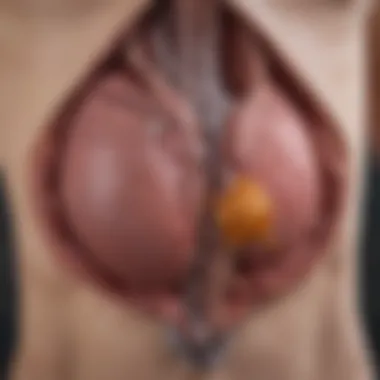Cirrhotic Liver Ultrasound: Diagnostic Insights


Intro
Liver cirrhosis is a significant medical condition that often leads to severe complications and increased mortality. Evaluating this disease effectively is crucial for timely intervention and management. Ultrasound technology plays a pivotal role in this evaluation process, offering a non-invasive and accessible method for diagnosing cirrhotic changes in the liver. This article aims to explore the comprehensive aspects of cirrhotic liver ultrasound, emphasizing its diagnostic capabilities, methodologies, and the implications it holds in clinical practice.
Research Background
Overview of the Scientific Problem Addressed
Cirrhosis arises from various chronic liver diseases, leading to progressive fibrosis and distortion of liver architecture. The traditional methods for evaluating liver status, such as biopsies, can be invasive and carry significant risks. Therefore, an effective imaging technique, like ultrasound, is needed to guide the diagnosis and management of liver cirrhosis, providing critical insights without the inherent risks of more invasive procedures.
Historical Context and Previous Studies
The use of ultrasound in hepatology dates back several decades. Initially, it was limited to anatomical assessment. However, advancements in technology have transformed ultrasound into a powerful tool for dynamically assessing liver parenchyma and identifying pathological changes associated with cirrhosis. Studies have demonstrated how ultrasound can detect hepatomegaly, ascites, and nodular liver contour, essential indicators of cirrhosis.
Ultrasound serves as a cornerstone in non-invasive assessments of liver cirrhosis, allowing for real-time visualization and interpretation of liver pathology.
Methodologies of Ultrasound in Liver Cirrhosis
Ultrasound methods can be categorized based on the type and approach used:
- Standard Ultrasound: This includes B-mode ultrasound that provides images of liver structure and can highlight abnormalities such as nodularity or hepatic enlargement.
- Doppler Ultrasound: This technique evaluates blood flow within the liver and surrounding vessels, aiding in the detection of portal hypertension, a common consequence of cirrhosis.
- Elastography: A more advanced modality, elastography measures liver stiffness, which correlates with fibrosis severity. This provides quantitative data that can enhance diagnostic accuracy.
Each of these methodologies contributes to a comprehensive assessment of liver condition, helping to determine the extent of cirrhosis and facilitating better clinical management.
Findings and Discussion
Key Results of Research
Recent findings underscore the efficacy of ultrasound in identifying cirrhosis and its complications. Studies show that ultrasound can detect liver abnormalities with a high accuracy rate, identifying up to 90% of cases in certain populations. Moreover, elastography has emerged as an indispensable tool in the assessment of liver stiffness, correlating well with histological findings.
Interpretation of the Findings
The ability to visualize the liver non-invasively presents multiple advantages. It reduces the need for more invasive procedures and minimizes patient discomfort. Furthermore, the increasing integration of ultrasound in clinical practice aids in timely diagnosis and appropriate treatment strategies for patients with cirrhosis.
Overall, ultrasound is a fundamental tool in the hepatologist's arsenal, ensuring sustained focus on careful monitoring and treatment planning based on the individual patient’s needs.
Preface to Cirrhosis
Cirrhosis represents a significant concern in liver health worldwide. It is a condition characterized by irreversible liver damage, leading to complications affecting various bodily functions. Understanding cirrhosis is crucial, as it establishes the foundation for recognizing the role of diagnostic tools like ultrasound in managing the disease.
The relevance of the introduction to cirrhosis lies in its multifaceted impact on health systems and patient outcomes. Patients with cirrhosis often experience complications such as liver failure, portal hypertension, and hepatocellular carcinoma. Thus, early detection and diagnosis play a vital role in improving patient management strategies. Without adequate knowledge about cirrhosis, healthcare professionals might overlook early signs, leading to delayed interventions and increased morbidity.
Pathophysiology of Cirrhosis
The pathophysiology of cirrhosis involves a complex interplay of various factors including inflammation, cell death, and tissue regeneration. Chronic insults to the liver, such as from hepatitis viruses, alcohol use, or metabolic disorders, lead to continuous injury. This injury results in hepatocyte death and subsequent fibrosis. Over time, the accumulation of fibrous tissue disrupts normal liver architecture, compromising its functions.
Cirrhosis induces changes that can be catastrophic for liver function. The liver's regenerative ability suffers as the balance between damage and healing becomes skewed. The deposition of scar tissue leads to increased portal pressure, which can cause complications like variceal bleeding and ascites. The understanding of this pathophysiology is crucial for appreciating ultrasound's role in the diagnostic process.
Epidemiology of Cirrhotic Conditions
Globally, the patterns of cirrhosis prevalence and incidence vary significantly. An estimated 1-5% of the adult population in developed countries suffer from liver cirrhosis, with variations in prevalence rates reflecting different risk factors and causes. In lower-income countries, chronic liver disease often results from infectious causes such as hepatitis, whereas developed nations see a higher prevalence linked to alcohol consumption and obesity.
Certain populations are at greater risk due to genetic predispositions or lifestyle factors. Men are statistically more susceptible to cirrhosis than women, likely due to higher alcohol consumption rates. This highlights the importance of targeted screening and educational interventions in high-risk groups.
Clinical Significance of Diagnosis
Diagnosing cirrhosis at an early stage holds great clinical significance. It enables timely interventions that can slow disease progression and enhance patient quality of life. Traditionally, diagnosis relied on clinical evaluation and liver biopsy. However, such methods can be invasive, and there is increasing reliance on non-invasive techniques, particularly imaging modalities like ultrasound.
Ultrasound, in particular, is non-invasive and can detect changes associated with cirrhosis, which may influence treatment pathways. Clinical outcomes can greatly improve when physicians utilize effective diagnostic tools early in the disease process.
"Early diagnosis is key in managing cirrhotic patients, potentially improving survival rates and quality of life."


Ultrasound Fundamentals
In the context of evaluating cirrhotic liver disease, understanding the fundamentals of ultrasound is paramount. This non-invasive imaging technique plays a vital role in the diagnosis and management of liver conditions. Ultrasound is favored for its accessibility, cost-effectiveness, and ability to provide real-time imaging without the use of ionizing radiation. It serves as a critical tool not just for the initial diagnosis of cirrhosis but also for ongoing monitoring and treatment planning.
Principles of Ultrasound Imaging
Ultrasound imaging involves the generation of high-frequency sound waves that are emitted from a transducer. These sound waves interact with different tissues within the body, reflecting back to the transducer and forming images based on the varying echo patterns. The principles of reflection, refraction, and absorption are key to interpreting the images obtained. Notably, the difference in acoustic impedance between various tissue types allows for detailed characterization of liver morphology, helping to distinguish between healthy and diseased tissue.
Types of Ultrasound Techniques
Ultrasound comprises various techniques that cater to specific diagnostic needs when assessing liver cirrhosis.
Conventional Ultrasound
Conventional ultrasound is often the first-line investigation for liver evaluation. It provides real-time images of the liver's structure and can identify abnormalities like nodularity or liver enlargement. A key characteristic of this technique is its ease of use, making it a popular choice among practitioners and for patients. Its unique feature is the non-invasive nature, which minimizes discomfort for the patient. However, conventional ultrasound has limitations in sensitivity and specificity for certain conditions.
Doppler Ultrasound
Doppler ultrasound focuses on the assessment of blood flow within the liver. It is particularly useful for identifying portal hypertension, a common complication in cirrhotic patients. This technique works by measuring changes in frequency of the echoes from moving blood cells. The ability to visualize blood flow patterns enhances the understanding of vascular alterations, making Doppler ultrasound a valuable tool. Its advantage lies in its capacity to provide insights into hemodynamics, but it may be influenced by operator experience and patient factors.
Contrast-Enhanced Ultrasound
Contrast-enhanced ultrasound employs microbubble contrast agents to improve the visualization of liver lesions and vascular structures. This technique can offer superior characterization of focal lesions which may be difficult to categorize with standard ultrasound. A distinguishing feature of this method is its capability to assess perfusion in real time, aiding in the identification of malignant lesions. Despite its benefits, availability of contrast agents and the need for specialized training can sometimes limit its application.
Preparation for Ultrasound Examination
Preparing a patient for an ultrasound examination is crucial for optimal imaging results. Patients are typically advised to fast for several hours prior to the procedure. This fasting period helps decrease the amount of gas in the gastrointestinal tract, allowing for clearer views of the liver. Additionally, the positioning of the patient during the exam impacts the quality of the images obtained. Knowledge of these preparation steps ensures that practitioners can effectively interpret ultrasound findings, minimizing the chances of misdiagnosis.
"In the domain of cirrhosis diagnosis, ultrasound techniques are indispensable tools that provide critical insights into liver pathology."
Learning these ultrasound fundamentals reinforces the importance of imaging in hepatology. Diagnostic accuracy can significantly influence patient outcomes, making expertise in ultrasound techniques essential for healthcare professionals. From evaluating liver morphology to understanding hemodynamics, ultrasound serves as a cornerstone in the comprehensive exploration of cirrhotic liver diseases.
Ultrasound Findings in Cirrhosis
Ultrasound imaging plays a crucial role in the diagnosis and management of cirrhosis. This section explores the various ultrasound findings that can indicate the presence of cirrhosis. It highlights key characteristics and provides insight into changes occurring in liver morphology, vascular structures, and extraparenchymal factors. Understanding these findings is essential for accurate assessment and clinical decision-making.
Hepatic Morphology Changes
Liver changes due to cirrhosis are significant for diagnosis. These alterations often present as specific patterns in ultrasound imaging.
Nodularity
Nodularity refers to the irregular surface of the liver observed on ultrasound. It is a key characteristic because it often indicates advanced liver disease. This aspect is beneficial as it can direct clinicians toward a cirrhosis diagnosis.
The unique feature of nodularity is that it reflects the architectural destruction in the liver. Advantages of identifying this can lead to early intervention, but it may also mislead if confused with other liver conditions. Nodularity is therefore an important finding underlining the complexity of liver pathology.
Liver Size Variations
Liver size variations can indicate the progression of cirrhosis. Measuring the liver size helps determine if it is enlarged, shrunken, or irregular.
This characteristic is important for diagnosis. A shrunken liver is often related to advanced cirrhosis, and enlarged liver may indicate early liver disease. The unique feature is that both conditions can occur during disease progression. The advantage lies in tracking size changes over time, but it may not always represent functionality of the liver. This can create confusion in prognosis.
Surface Irregularities
Surface irregularities of the liver are another ultrasound finding that provides insights into cirrhosis. An irregular surface can suggest a nodular liver often affecting the liver's function.
This factor is beneficial as it can indicate fibrosis or scarring. The unique feature of surface irregularities is their ability to show changes in liver texture and function. Such findings often support the diagnosis of cirrhosis but can be misinterpreted as benign changes. Understanding the full ultrasound narrative is crucial in these cases.
Vascular Alterations
Vascular changes are significant findings in patients with cirrhosis, often indicating complications related to liver disease.
Portal Vein Thrombosis


Portal vein thrombosis is a serious condition in cirrhosis patients. It occurs when a clot forms in the portal vein, leading to complications in blood flow.
This aspect is crucial as it can hamper liver function and cause portal hypertension, making it a significant finding on ultrasound. The unique feature of portal vein thrombosis is its impact on both liver and spleen. The advantage of identifying it early is critical for managing complications, although misdiagnosis can lead to a failure in treatment plans.
Splenic Vein Thrombosis
Splenic vein thrombosis can occur with portal vein obstruction and often presents during the advanced stages of cirrhosis.
This finding is significant because it can lead to splenomegaly and further complications. The key characteristic is its link to portal vein thrombosis. Its unique feature is the potential for extra-hepatic complications, which are important for patient management. This also helps differentiate cirrhosis-driven changes from other liver diseases. Monitoring is essential to mitigate the risks involved.
Flow Reversal
Flow reversal indicates abnormal blood flow patterns in patients with cirrhosis. This can be observed in the portal or hepatic veins on ultrasound imaging.
This characteristic is significant as it points to significant vascular changes due to cirrhosis. The unique feature of flow reversal is the demonstration of altered hemodynamics. The advantages include its ability to signal complications such as portal hypertension. However, this can also lead to confusion in acute liver conditions.
Extraparenchymal Findings
Extraparenchymal ultrasound findings are integral to understanding the full clinical picture in cirrhosis.
Ascites
Ascites is the pathological accumulation of fluid in the abdominal cavity. It is one of the most common ultrasound findings in cirrhosis.
The key characteristic of ascites is its direct correlation with increased portal pressure. This is beneficial for diagnosing liver cirrhosis. Its unique feature lies in the ability of ultrasound to quantify and detect fluid levels, aiding in management decisions. However, careful consideration is needed as ascites can also present in other conditions.
Spleen Size and Changes
Enlargement of the spleen, or splenomegaly, is another important finding in cirrhosis.
This aspect is critical as it often correlates with portal hypertension. The key characteristic of spleen enlargement provides insights into disease severity. Its unique feature is the trend monitoring of spleen size over time, helping in assessing disease progression. Notably, spleen size variation must be contextualized within overall clinical conditions to avoid misinterpretation.
Gallbladder and Biliary System Evaluations
Gallbladder and biliary system evaluations can indicate complications related to cirrhosis. Ultrasound assists in assessing biliary dilatation, gallstones, or cholecystitis.
The key characteristic of evaluating the biliary system is the detection of obstructive changes. This makes it a beneficial aspect of a comprehensive ultrasound examination. The unique feature lies in revealing associated conditions with cirrhosis, elevating the overall diagnostic acumen. However, relying solely on gallbladder findings might mislead conclusions regarding liver function.
Diagnostic Challenges
The assessment of liver cirrhosis through ultrasound is not without complications. There are various diagnostic challenges that can affect the accuracy and reliability of ultrasound findings. These include inherent limitations of the imaging technique itself, difficulties in distinguishing cirrhosis from other hepatic conditions, and the necessity for complementary imaging strategies to achieve a definitive diagnosis. Addressing these challenges is crucial for healthcare professionals to make informed clinical decisions, ensuring proper management of cirrhotic patients.
Limitations of Ultrasound in Cirrhosis
While ultrasound is a non-invasive method widely used for liver assessment, it has certain limitations. The ability to visualize liver morphology can be hindered by body habitus, where obesity can obscure structures. Moreover, small or early-stage cirrhotic changes may not be readily apparent on ultrasound. The spatial resolution of ultrasound is lower compared to other imaging modalities, potentially missing subtle pathologies that could affect clinical outcomes.
Differentiating Cirrhosis from Other Liver Conditions
Cirrhosis may present with overlapping features found in other liver diseases, making differentiation challenging. Hepatitis, fatty liver disease, and liver tumors can present similar ultrasound appearances such as abnormal echogenicity or nodularity. A thorough understanding of specific imaging characteristics is essential. Without careful interpretation, there is a risk of misdiagnosis, which could lead to inappropriate management strategies.
Role of Complementary Imaging Modalities
CT Scanning
CT scanning provides detailed cross-sectional images of the liver, allowing for better visualization of hepatic architecture compared to ultrasound. Its high sensitivity to various liver abnormalities makes it a popular option for assessing cirrhosis. The unique characteristic of CT is its ability to rapidly capture multiple phases of enhancement, which is beneficial in evaluating vascular structures and detecting complications such as vascular thrombosis. However, CT involves ionizing radiation and may not be suitable in certain patient populations.
MRI
MRI has become an invaluable tool in liver evaluation. It offers excellent soft tissue contrast and can evaluate the liver’s vasculature without radiation exposure. The key characteristic of MRI is its ability to characterize liver lesions with higher accuracy. In the context of cirrhosis, it can reveal chronic changes and assess complications like hepatocellular carcinoma. On the downside, MRI is more time-consuming and expensive, which can limit its use in certain situations.
Elastography
Elastography is a promising technique that quantifies liver stiffness, which correlates with fibrosis. Its growing relevance in cirrhosis assessment arises from its non-invasive nature and capacity to provide precise measurements. The unique feature of elastography is its ability to differentiate between various stages of liver fibrosis and cirrhosis without the need for a biopsy. Nonetheless, factors such as operator dependency and the need for proper patient selection can pose challenges for accurate interpretation.


Recognition of these diagnostic challenges in liver ultrasound is essential. Understanding the limitations, differentiating factors, and the role of other imaging modalities is vital in the comprehensive evaluation of cirrhotic liver disease.
Clinical Correlations
Understanding the clinical correlations in ultrasound examination of cirrhotic liver disease is critical. This section delves into how ultrasound findings are directly linked to patient management and outcomes. Through effective assessment of liver function, monitoring disease progression, and guiding treatment decisions, ultrasound serves as a key tool in hepatology.
Assessment of Liver Function
Assessment of liver function through ultrasound includes evaluating anatomical features and vasculature, allowing for indirect quantification of liver parenchyma. Factors like liver size, echogenicity, and the presence of nodularity provide valuable insights into liver function. A hyperechoic liver may suggest steatosis, while hypoechoic nodules could indicate regenerative changes typical in cirrhosis.
Moreover, Doppler ultrasound enhances this assessment. It evaluates blood flow dynamics within the hepatic vasculature. For instance, changes in the portal vein flow can indicate portal hypertension or hepatic venous outflow obstruction. Understanding these dynamics is essential in assessing the liver's functional capacity, thereby influencing clinical decisions.
Monitoring Disease Progression
Monitoring disease progression is integral to managing cirrhosis. Regular ultrasound examinations can track changes over time, identifying new nodules or alterations in liver size. Such monitoring assists in stratifying risk of complications like hepatocellular carcinoma.
Ultrasound findings such as ascites, varices, or splenomegaly reflect worsening liver function and the need for increased clinical vigilance. An increase in ascitic volume can signal a deteriorating condition, which demands urgent assessment and tailored management strategies. Thus, the ability to visualize these changing dynamics informs the prognosis and guides clinical management.
Guiding Treatment Decisions
Ultrasound findings play a pivotal role in guiding treatment decisions in cirrhosis. For example, identification of vascular changes can determine urgency for intervention in cases of portal vein thrombosis. In patients with significant ascites, ultrasound can guide therapeutic drainage procedures.
Additionally, ultrasound helps in evaluating the effectiveness of treatments. Changes in liver architecture or resolution of biliary obstruction after a procedure can be assessed through ultrasound, helping to refine ongoing management. Access to this real-time information allows clinicians to make informed, timely decisions suited to the patients' evolving needs.
Key Point: The integration of ultrasound findings with clinical assessment optimizes patient management in liver cirrhosis, enhancing outcomes through targeted interventions.
Future Directions in Ultrasound Technology
The landscape of ultrasound technology is in a constant state of evolution. As we look ahead, there are significant advancements that hold promise for improving the diagnosis and management of cirrhotic liver disease. Innovations in equipment, artificial intelligence, and new diagnostic protocols are reshaping how healthcare professionals interact with ultrasound technology. This section explores these emerging trends in detail, emphasizing how they can enhance the understanding and treatment of liver conditions.
Advancements in Ultrasound Equipment
Recent advancements in ultrasound equipment have the potential to greatly improve diagnostic accuracy in cirrhotic liver evaluation. Modern ultrasound machines incorporate high-frequency transducers that enhance resolution. These improvements allow for better visualization of liver architecture, thus facilitating the detection of subtle changes associated with cirrhosis.
Additionally, portable ultrasound devices are becoming more common. They provide flexibility in clinical settings and enable rapid bedside evaluations. Devices like the Philips Lumify extend traditional ultrasound capabilities to mobile technology, allowing for timely decisions in patient care.
Furthermore, the development of multi-frequency and multi-modality equipment enables simultaneous imaging using ultrasound, CT, or MRI. This integration can offer a more comprehensive view of hepatic conditions and disease progression, making it easier for clinicians to determine appropriate treatment strategies.
AI and Machine Learning in Ultrasound Interpretation
The integration of artificial intelligence and machine learning in ultrasound interpretation is a transformative step in radiology. Algorithms can analyze thousands of imaging data points quickly, enhancing diagnostic precision. By identifying patterns within the ultrasound images, AI systems can assist in distinguishing between benign and malignant lesions, aiding in the differentiation of cirrhosis from other liver pathologies.
Training AI systems requires extensive datasets. Continual improvements in data annotation will further refine these algorithms. For instance, algorithms capable of detecting and classifying liver nodularity can enhance the ability to predict cirrhosis severity and associated complications. However, it is essential to maintain clinical oversight since AI support is meant to complement, not replace, the expertise of healthcare professionals.
Potential for New Diagnostic Protocols
The evolution of ultrasound technology presents the opportunity to develop new diagnostic protocols that can standardize and optimize the evaluation of cirrhotic conditions. Implementing systematic ultrasonography approaches, such as the use of elastography, can provide insights into liver stiffness, which correlates with fibrosis stage. This kind of protocol could streamline the assessment process, making it more efficient and reliable.
Moreover, incorporating ultrasound findings into broader clinical pathways will likely enhance clinical decision-making. For example, a unified protocol for liver disease assessment could include ultrasound findings alongside laboratory results and patient history. This multi-faceted approach could improve outcomes by ensuring comprehensive evaluations that guide treatment decisions effectively.
"Emerging technologies in ultrasound are set to revolutionize the field, enabling not just better diagnostics but also more personalized treatment strategies for cirrhotic liver disease."
Epilogue
In summation, the exploration of ultrasound in the context of cirrhotic liver disease reveals a multifaceted approach to diagnosis and patient management. This article highlights the inherent significance of ultrasound technology as a non-invasive and cost-effective imaging modality. It allows clinicians to detect, monitor, and evaluate the complex changes associated with cirrhosis. The understanding of ultrasound findings is crucial as it aids in making informed decisions regarding treatment and interventions for patients.
Summary of Key Points
The discussion surrounding cirrhotic liver ultrasound can be condensed into several essential points:
- Role in Diagnosis: Ultrasound plays a vital role in identifying hepatic morphological changes, vascular alterations, and extraparanchymal findings.
- Limitations Acknowledged: There are challenges in diagnosis, such as distinguishing cirrhosis from other liver pathologies and the inherent limitations tied to ultrasound technology itself.
- Future Innovations: Ongoing advancements in ultrasound equipment and the integration of artificial intelligence enhance the diagnostic capabilities, promising even more efficient protocols in the near future.
- Clinical Relevance: The findings from ultrasound imaging correlate directly with disease progression and liver function, having direct implications on patient management.
Implications for Clinical Practice
The implications of effective ultrasound use in the practice of hepatology cannot be understated. Here are some key considerations:
- Patient-Centric Approach: By utilizing ultrasound as a primary assessment tool, providers can offer less invasive procedures, significantly increasing patient comfort and compliance.
- Interdisciplinary Utility: Ultrasound findings can guide hepatologists, radiologists, and surgical teams in crafting tailored treatment plans.
- Research Potential: The insights gained through ultrasound imaging pave the way for further research into cirrhotic diseases and exploration of additional diagnostic technologies.
- Training and Education: Understanding ultrasound applications in cirrhosis should be an integral part of medical training for future practitioners, thus enhancing the overall quality of care for patients.
Ultimately, the importance of ultrasound in managing cirrhotic liver disease extends beyond its immediate diagnostic capacity. It lays a foundation for improved patient outcomes through timely and accurate interventions.







